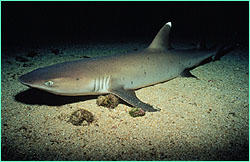A while ago I wrote about how I dislike the practice of chumming to lure sharks to dive cages for the purposes of photography. Cage diving is very popular in South Africa and generates a good income for the various operators who gear their dives to tourists and thrill seekers. These operators cater to divers and non-divers alike since many of them will not require SCUBA certification for the cage dives. One of the shark attacks mentioned in the Dive South Africa blog happened close to where cage diving and chumming occur.
As I wrote previously, I do not think that chumming can have a good outcome. Personally, I believe that if we are to enjoy marine life we should interfere as little as possible with the way the animals behave naturally. If that means that we have to wait a little longer for a shark to appear then so be it.
Recently, there was an interesting documentary on television about Shark Mountain in the Cocos Islands. This particular site has rich diversity of marine life with an abundance of various shark species. It was fascinating to see the documentary makers prepare for their dives, and how they dove amongst literally hundreds of hammerheads.
One very interesting scene in the documentary showed the mating behavior of white tipped sharks. According to the
 narrator, it was the first time in twenty years of diving that he was able to see the mating ritual from start to finish. It was very violent and the female was left bleeding and exhausted. For a while, I was concerned that the males would kill the female in the mating ritual. Apparently, these sharks have the most violent mating behavior of the shark family. It is surprising that the species manages to survive such violent social behavior. Most interesting though was the documentary maker was not in a cage and was probably within 20 yards/meters or so from the sharks.
narrator, it was the first time in twenty years of diving that he was able to see the mating ritual from start to finish. It was very violent and the female was left bleeding and exhausted. For a while, I was concerned that the males would kill the female in the mating ritual. Apparently, these sharks have the most violent mating behavior of the shark family. It is surprising that the species manages to survive such violent social behavior. Most interesting though was the documentary maker was not in a cage and was probably within 20 yards/meters or so from the sharks.I guess the point of this post is to contrast various ways in which we can interact with the top predator in the sea. It might mean that we have to travel further, spend more time researching and waiting, but in my opinion it is safer to observe the sharks in their natural environment without introducing any external influences like chumming. However, having said all that, I would not like to encounter a great white face to face without the security of a cage. I guess most other species I would not have too much trouble with, but the great whites still get my adrenaline pumping!
PS: 10/26/05 noticed an interesting link on Divester about a shark video in South Africa. Worth watching. Thanks Bill.

No comments:
Post a Comment